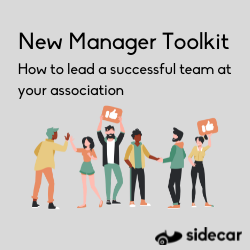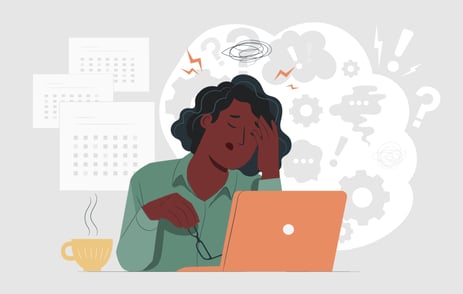Today, there is no shortage of burnout-related headlines – from 117,000 healthcare workers leaving the industry to tech companies springing up to use big data to track burnout symptoms. While most of them are focused on preventing, detecting and combating burnout, the reality is they’re missing one big issue – for a lot of people, burnout already happened.
Burnout recovery can be difficult, particularly without the support from the place that often causes it: Work. For association leaders, knowing how to empower staff and working as an ally in recovery should be a top priority.
But how can associations take an active role in doing so, and what does burnout recovery look like for those staffers doing it on their own?
What Is Burnout Doing To You?
Before diving into how to recover from burnout, we first need to understand what it’s actually doing to people. Burnout is a form of chronic stress that affects a person's emotions and mental health. It can be caused by many factors, including work overload, long working hours, lack of control over one’s work, and exposure to highly stressful events (such as trauma).
Burnout can affect your staff and members in a few different ways. For starters, the effects are similar to those felt from sleep deprivation.
- You become physically exhausted and emotionally drained.
- You lose motivation and interest in things that once brought you joy, like hobbies or spending time with friends and family.
However, in more severe cases, it can pose significant health implications. Physical symptoms like headaches, stomach pain and trouble sleeping can arise along with cognitive difficulties such as impaired concentration or memory loss.
The most severe symptom of burnout is depression. However, it’s important to note that while stress can lead to depression, not all people who experience stress will develop it.
5 Burnout Recovery Strategies to Make a Comeback
Everyone can agree that burnout is a problem affecting every industry. As associations and leaders, you can be a part of the burnout recovery process. Whether you’re offering advice or facilitating some of the strategies, here are five steps for burnout recovery.
1. Set Boundaries
One of the biggest reasons people suffer from burnout is that they rarely disconnect from work. After returning to the office, be sure you set boundaries in all aspects – from your availability for meetings to a hard stop at the end of the day.
More importantly, stick to them. Whether that means removing your work email from your phone, adding focus times on your devices to silence notifications or (for those who really struggle) putting your devices in a secure area out of sight, the point is knowing how to say no and not reverting to the behaviors that led to burnout in the first place.
For Organizations: Culture often influences why staffers feel the need to always be on. Just like they can do the work to disconnect, association leaders should help facilitate that. An easy way to start is with scheduled sends. Whether it’s your emails or instant messages, if you’re starting to type out a message after hours, be sure to schedule it to arrive during working hours!
2. Get Help Where You Need It
Feeling overworked? Have a project you simply can’t handle? Be open and transparent about needing help and the problems that lead to your burnout. Manageable workloads are a must – regardless of team size. So whether that means working with your manager to delegate or eliminate tasks altogether, or seeing who else on your team can step in to assist, creating a manageable workload needs to be a priority.
For Organizations: While responding when a staffer steps up and lets you know they’re burned out is great, chances are it isn’t going to happen. This is where your leadership skills and emotional intelligence come into play. Weekly one-on-ones can be a valuable tool to develop this connection with your staff. Not only is it a safe space for them to communicate privately, but it also allows you to understand the nuances that signal burnout is a problem. And when someone does come to you for help, be prepared to take their concerns seriously and find ways to help them ease their workload.

New Manager Toolkit
New to a leadership role in your association? Be sure you have the skills and resources needed to empower your staff!
Download Now
4. Create “You” Time
Remember the things that make you happy. From relaxing hobbies to time with friends and family, creating boundaries and enjoying time away from work can help you decompress and eliminate any work-related stress. These things often fall by the wayside once you’re over a burnout limit. Being intentional about how and where you spend your time can help start your road to burnout recovery.
For Organizations: Set the tone for your staff. Breaks are necessary and vacation time should be an essential tool for your association. Be clear about your policies and encourage your team to take time off. And remember, your actions are more important than your words – if leaders want their staff to take breaks, they need to take them as well.
5. Make a Change
Of course, in the worst-case scenario, burnout again takes hold of your work life. If your organization isn’t doing anything to stop it and your other strategies aren’t working, it may be time to make a change. Whether that means looking for a new role or resigning altogether, your mental health and happiness should always be a priority.
Recovery Takes Work
While many associations are already working hard to curb burnout, it’s important to look for and support your staffers who are past their breaking point. The way we work is changing, and while associations benefit from being mission-driven, even staff invested in that culture and purpose can become burned out.
Finding ways to support them, whether through one-on-one communication, work distribution or encouraging time off, needs to be a top priority for your association's leadership.
Tags:
Association Management
October 27, 2022


